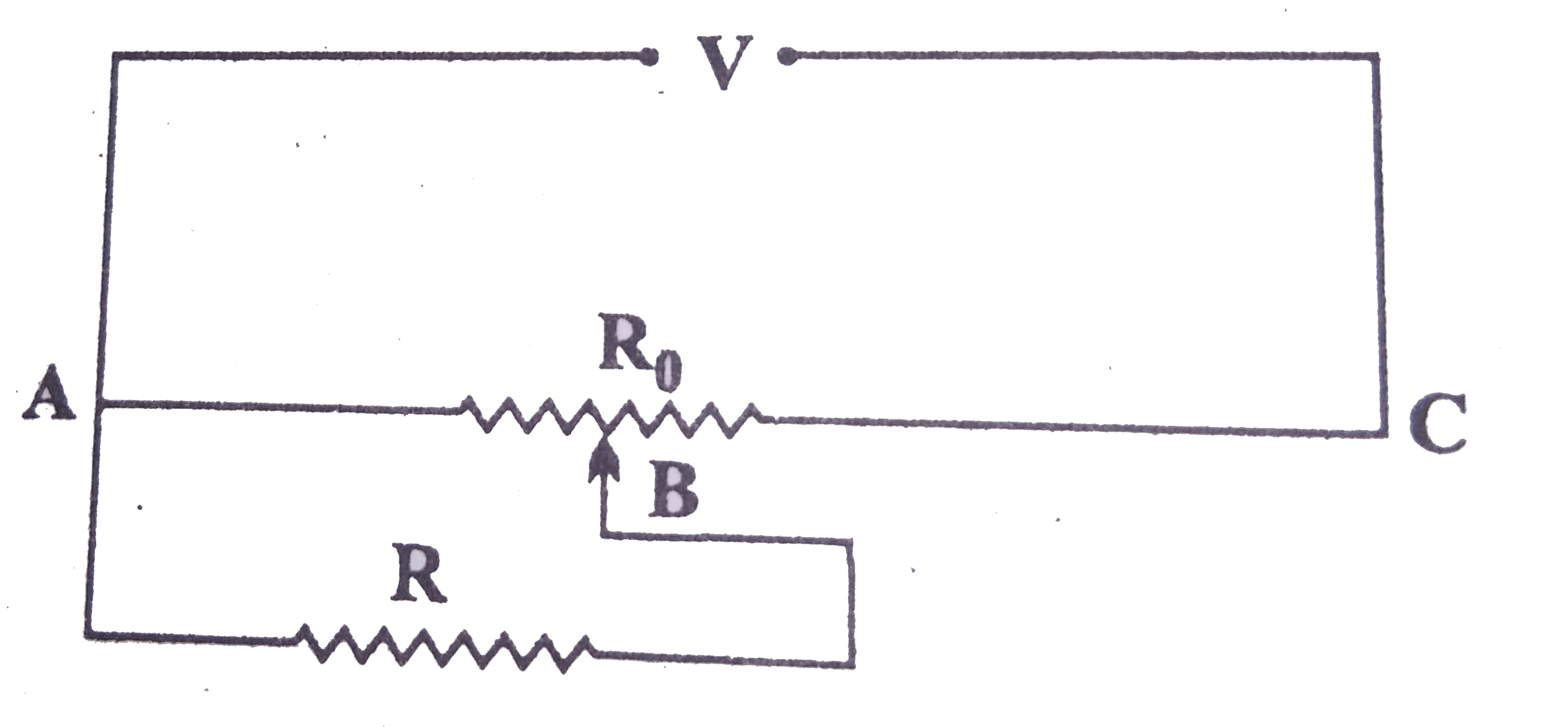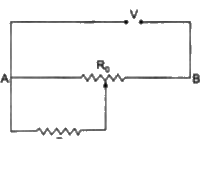A rsisitance of RΩ draws current from a potentiometer. Te potentiometer has a total resistance R0Ω A voltage V is supplited to the potentiometer. Derive an expression for the voltage across R when the sliding contact is in the middle of the potenttometer.
 Solution in Gujrati
Solution in Gujrati
While the silde is in the middle of the potentiometer only half of its resistance (R0/2) will be between the points A and B. Hence, the toal resictance between A and B, say, R1, will be given by the following expression:
1R1=1R+1(R0/2)
R1=R0RR0+2R
The total resistance between A and C will be sum of resistance between A and B and B and C, i.e., R1+R0/2
∴ The current following through the potentiometer will be
I=VR1+R0/2=2V2R1+R0
The voltage V1 taken from the potentiometer will be the product of current I and resistance R1,
V1=IR1(2V2R1+R0)×R1
V1=2V2(R0×RR0+2R)+R×R0×RR0+2R
V1=2VR2R+R0+2R
or V1=2VRR0+4R
Topper's Solved these Questions
- CURRENT ELECTRICITY BOOK - NCERT GUJARATICHAPTER - CURRENT ELECTRICITY EXERCISE - EXERCISES
12 Videos
- CURRENT ELECTRICITY BOOK - NCERT GUJARATICHAPTER - CURRENT ELECTRICITY EXERCISE - ADDITIONAL EXERCISES
9 Videos
- ATOMSBOOK - NCERT GUJARATICHAPTER - ATOMSEXERCISE - ADDITIONAL EXERCISE
10 Videos
- DUAL NATURE OF RADIATION AND MATTERBOOK - NCERT GUJARATICHAPTER - DUAL NATURE OF RADIATION AND MATTEREXERCISE - EXERCISES
41 Videos
Similar Questions
The storage battery of a car has an emf of 12 V. If the internal resistance of the battery is 0.4Ω what is the maximum current that can be drawn from the battery ?
View SolutionThe earth's surface has a negative surface charge density of 10−9Cm−2. The potential difference of 400 kV between the top of the atmosphere and the surface results (due to the low conductivity of the lower atmosphere) in a current of only 1800 A over the entire globe. If there were no mechanism of sustaining atmospheric electric field, how much time (roughly) would be required to neutralise the earth's surface? (This never happens in practice because there is a mechanism to replenish electric charges. namely tghe coontainual thunderstorms and lighting in different parts of the globe). (Radius of earth =6.37×106m.)
View SolutionAnswer the following questions, which help you understand the difference between Thomson’s model and Rutherford’s model better.
(a) Is the average angle of deflection of a-particles by a thin gold foil predicted by Thomson’s model much less, about the same, or much greater than that predicted by Rutherford’s model?
View SolutionFind the
(a) maximum frequency, and
(b) minimum wavelength of X-rays produced by 30 kv electrons.
View Solution
A constant voltage V0 is applied to a potentiometer of resistance R connected to an ammeter. A constant resistor r is connected to the sliding contact of the potentiometer and the fixed end of the potentiometer. How will the reading of ammeter vary as the sliding contact is moved from one end of the potentiometer to the other ? The resistance of ammeter is assumed to be negligible.
View SolutionRΩ का कोई प्रतिरोध एक पोटेंशियोमीटर से विघुत धारा प्राप्त कर रहा है पोटेंशियोमीटर का कुल प्रतिरोध R0Ω है । ( चित्र 3 .29 ) पोटेंशियोमीटर को वोल्टता V की आपूर्ति की गयी है l जब सर्पी संपर्क ( सरकने वाला भाग या स्लाइड ) पोटेंशियोमीटर के तार के मध्य के हो तो R के सिरों पर वोल्टता के लिए व्यंजक प्राप्त कीजिए l

View SolutionA resistance of RΩ draws current from a potentiometer. The potentiometer has a total resistance R0Ω. A voltage V is supplied to the potentiometer. Dervie can expression for the voltage across R when the sliding contact is in the middle of the potentiometer.

View SolutionRΩ का एक प्रतिरोध एक विभवमापी से विद्युत धारा प्राप्त कर रहा है । विभवमापी का कुल प्रतिरोध R0Ω है । विभवमापी को वोलटता V की आपूर्ति की गई है । जब सप्री संपर्क ( सरकने वाले भाग या स्लाइड ) विभवमापी के तार के मध्य में हो , तो R के सिरों पर वोलटता के लिए व्यंजक प्राप्त कीजिए ।

View SolutionRΩ का कोई प्रतिरोध एक विभवमापी से विद्युत धारा प्राप्त कर रहा है। विभवमापी का कुल प्रतिरोध R0Ω है। विभवमापी को वोल्टता V की आपूर्ति की गई है। जब सर्पी सम्पर्क (सरकने वाला भाग या स्लाइड) विभवमापी के तार के मध्य में हो R के सिरों पर वोल्टता के लिए व्यंजक प्राप्त कीजिए।

View SolutionA resistance of R draw current from a potentiometer. The potentiometer wire, AB, has total resistance of R0. A voltage V is supplied to the potentiometer. Derive an expression for the voltage across R when the sliding contact is in the middle of potentiometer wire.

View SolutionIn a potentiometer experiment if the voltage across resistance R and R + r are balanced at the length l1andl2 respectively the value of resistance r will be
View SolutionA resistance of R Omega draws current from a potentiometer as shown in Fig. The potentiometer has a total resistance R_0 Omega . A voltage Vis supplied to the potentiometer. Derive an expression for the voltage across R when the sliding contact is in the middle of the potentiometer.
View SolutionA resistance of R Omega draws current from a potentiometer. The potentiometer has a total resistance R _(0) Omega. A voltage V is supplied to the potentiometer. Derive an expression for the voltage across R when the sliding contact is in the middle of the potentiometer.
View SolutionA resistance of R draws current from a potentiometer. The potentiometer wire, AB , has a total resistance of R0, A voltage V is supplied to the potentiometer. Derive an expression for the voltage across R when the sliding contact is in the middle of potentialmeter wire.

View SolutionA voltage V is supplied to a potentiometer wire of resistance R_0 . A resistance R is connected as shown. Find voltage across R when the sliding contact is at the middle of potentiometer wire
View Solution
